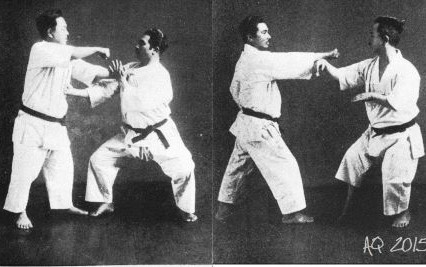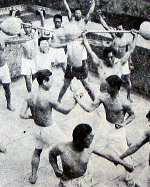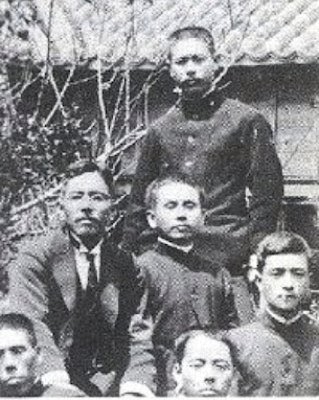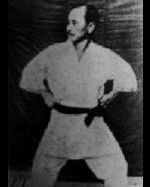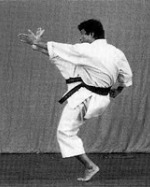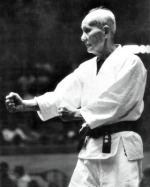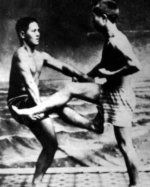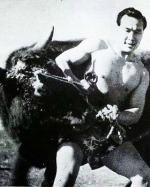Kenwa Mabuni – Founder of Shito-Ryu Karate
Talk the Talk
When Kenwa Mabuni first started his karate school in Japan in 1929, he named the style Hanko (half-hard).
However, within a few years, he had renamed it to its current name, Shito-Ryu, which he derived from the first two Okinawan characters from the family name of each of his
original masters, known to us as Anko Itosu and Kanryo Higaonna, (with Ryu meaning school).
Walk the Walk
When sparring with his students, Kenwa Mabuni would invite continued attacks from them while he just moved out of the way and blocked, repeatedly asking the student, “Now do you understand".This would have encouraged the student to improve his attacking skills and clearly demonstrated the importance f defence as you cannot lose a fight
if you do not get hit.
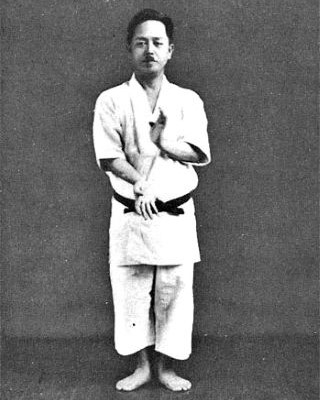
Kenwa Mabuni (1889 – 1952) was a member of the warrior class on Okinawa and came from a long line of fighters from the Onigusukini samurai family, who served the ruling elite on the island for hundreds of years.
Growing up Mabuni was a weak and sickly child but at the age of thirteen, he started learning martial arts under the renowned master Anko Itosu (commonly considered the grandfather of modern-day karate) of the Shuri-Te school. He trained every day and his health soon began to improve and as he grew stronger, he excelled at the martial arts under the guidance of his teacher.
Later in around 1909, he began studying the Naha-Te style of Okinawan martial arts under Kanryo Higaonna, who he had been introduced to by his friend Chojun Miyagi (who would later found Goju-Ryu karate). While in Naha, he also studied under another great master, Seisho Arakaki who taught him to use weapons effectively, in particular the bo staff and sai, along with various weapons kata.
Advanced Training in the Martial Arts
After finishing high school and the required military service that followed it, Sensei Mabuni became a police officer in Okinawa and was a respected member of the community known for his fairness and sense of justice for all. Though by now he was an accomplished karateka in his own right, he continued studying with his masters until 1915, both Itosu and Higaonna passed away within a short time of each other which would have devastated Mabuni and their other students. After the death of his original teacher Itosu, Mabuni is said to have built a shrine near the site of his grave and practised kata there daily for an entire year to honour the great master.
A few years later, along with other up-and-coming Okinawan karateka such as Chojun Miyagi and Gichin Funakoshi (who would later found Shotokan karate), he was involved in a dojo called Ryukyu Tode Kenkyu Kai (the Okinawan Karate Research Club). Another master involved in the project was Woo Yin Gue, a Chinese tea merchant living in Okinawa who taught Kenwa Mabuni Fukien Province White Crane kung fu, which is believed to have influenced the Shito-Ryu kata Rohai and Nipaipo.
In 1918, Mabuni was one of the members of the Ryukyu Tode Kenkyu Kai chosen to demonstrate Okinawan karate, then known as Tode or Te, to visiting members of the Japanese Royal family who were so impressed they ask the club to send a representative to teach the art in Japan. In 1922, Gichin Funakoshi was chosen for the task but other members, including Master Mabuni, made frequent trips to Japan to teach.
The Development of Shito-Ryu Karate
In the meantime, Mabuni continued with the development of his art by training with and sharing knowledge with the other members of the Ryukyu Tode Kenkyu Kai. In 1924, Mabuni was asked, along with his friend Chojun Miyagi, to head up the training sessions of the club. Together they stressed the importance of regular sparring in order to practice attacks and defensive moves on a moving opponent while improving control and the intensity of the techniques they used.
In 1929 at the age of thirty-nine, Master Mabuni permanently moved to the city of Osaka in Japan to teach his own style of karate, Shito-Ryu. It was a unique blend of Okinawan karate styles and included some kung fu as Mabuni took the best of what he had learned from his teachers to form a coherent version of the martial art that today is practised by millions of people across the world.
The main philosophy of Kenwa Mabuni’s teachings were laid out in the Go Do Shin (Five Way Spirit/Path) of Shito-Ryu Karate:
- Determination - Never forget the spirit of first beginning.
- Morality - Never neglect courtesy and etiquette.
- Development - Never neglect effort.
- Common sense - Never lose common sense.
- Peace - Never disturb harmony.
Early in the history of Shito-Ryu, Mabuni had to work hard to get his style accepted by the populace of Osaka. He performed many public demonstrations which included breaking bricks and boards with his hands and feet. He also gave free lessons to various police stations across Japan and established the Dai Nihon Karate Do Kai in 1931, the forerunner to the modern-day World Shito-Kai Karate-Do Federation.
Gradually the style took hold and Sensei Mabuni found more and more students, both at his dojo in Osaka and at universities that wanted to form dojos of their own. During World War Two, membership dropped in his clubs due to so many young men fighting in the conflict and like many others, Mabuni suffered great poverty during this period but persevered with his chosen art. Once the war had ended, things began to improve and karate student numbers rose across the country. His senior students helped further the development of Shito-Ryu history by opening clubs of their own across Japan and by the time of his death in 1952, the style was becoming increasingly popular.
Kenwa Mabuni’s son, Kenzo, took over as head of Shito-Ryu Karate and dedicated his life to teaching the art his father developed. Over the years, he and other masters who had been taught by Kenwa started to teach outside of Japan which led in time to Shito-Ryu becoming one of the four main traditional karate styles and one of the most practised and best-loved world martial arts there is.
Written by Andrew Griffiths – Last updated 27/06/2023. If you like
what you see, consider following the History of Fighting on social media.
Find Us On:



Further Reading:
Bushido-Kai Karate. [Internet]. 2020. Mount Holyoke Collage. Available from: https://www.mtholyoke.edu/org/karate/rightframe.html [Accessed Mar 30, 2020].
Five Way Spirit of Shito-Ryu Karate-Do. [Internet]. 2015. Shuriway Karate & Kobudo Website. Available from: http://www.shuriway.co.uk/godoshin.html [Accessed Mar 30, 2020].
Kenwa Mabuni. [Internet]. 2019. Shitoryu.org. Available from: http://www.shitoryu.org/bios/mabuni/mabuni.htm [Accessed Mar 30, 2020].
Kenzo Mabuni. [Internet]. 2020. Shito Ryu International Karate Do Kai. Available from: http://www.karatekobudo.com/karate/grand-masters/kenzo.htm [Accessed Mar 30, 2020].
More Karate History
Karate History Home
The history of karate begins in Okinawa, where martial arts were influenced by both kung fu from China, and the Japanese samurai. After weapons were banned on the island, unarmed combat techniques were developed into a style of fighting recognisable as traditional karate, which was further developed after being taken to Japan in the early twentieth century by Gichin Funakoshi.
The history of karate begins in Okinawa, where martial arts were influenced by both kung fu from China, and the Japanese samurai. After weapons were banned on the island, unarmed combat techniques were developed into a style of fighting recognisable as traditional karate, which was further developed after being taken to Japan in the early twentieth century by Gichin Funakoshi.
The History of Okinawan Karate
A look at the history of Okinawan karate and how it developed from the seventeenth century. Okinawan martial arts had influences from both the Japanese samurai and Chinese kung fu, as well as techniques unique to the island itself which over the years blended and evolved into the traditional karate styles that are practiced all over the world today.
A look at the history of Okinawan karate and how it developed from the seventeenth century. Okinawan martial arts had influences from both the Japanese samurai and Chinese kung fu, as well as techniques unique to the island itself which over the years blended and evolved into the traditional karate styles that are practiced all over the world today.
The Life and Legends of Anko Itosu
Anko Itosu was a legendary Okinawan martial artist and a pioneer in the development of karate history. He popularised many aspects of the fighting system through his Shuri-te style and helped increase the number of people who were permitted to learn it by bringing karate training out of secrecy, and even gained permission to teach it in Okinawan schools.
Anko Itosu was a legendary Okinawan martial artist and a pioneer in the development of karate history. He popularised many aspects of the fighting system through his Shuri-te style and helped increase the number of people who were permitted to learn it by bringing karate training out of secrecy, and even gained permission to teach it in Okinawan schools.
Gichin Funakoshi - Father of
Modern Day Karate
Gichin Funakoshi was born in Okinawa in 1868 and is known as the father of modern-day karate due to the innovations he made to Okinawan martial arts when he took it to Japan and popularised it with the people there. Not only did he found Shotokan karate, but he was also instrumental in spreading karate across the world.
Gichin Funakoshi was born in Okinawa in 1868 and is known as the father of modern-day karate due to the innovations he made to Okinawan martial arts when he took it to Japan and popularised it with the people there. Not only did he found Shotokan karate, but he was also instrumental in spreading karate across the world.
The History of the Shotokan Kata – Part One
A look at the history of the more basic Shotokan kata, including their origins, development, interesting facts and scholastic debate. This list of kata histories includes, Kihon kata, the Heian kata, the Tekki group, Bassai Dai and Sho, Empi, Hangetsu, Kanku Sho and Dai, Jion, Ji’in and Jitte and includes video links to the relevant kata.
A look at the history of the more basic Shotokan kata, including their origins, development, interesting facts and scholastic debate. This list of kata histories includes, Kihon kata, the Heian kata, the Tekki group, Bassai Dai and Sho, Empi, Hangetsu, Kanku Sho and Dai, Jion, Ji’in and Jitte and includes video links to the relevant kata.
The History of the Shotokan Kata – Part Two
A look at the history of the more advanced Shotokan kata, including their origins, development, interesting facts and debated issues. This list of karate kata histories includes, Wankan, Gankaku, Meikyo, Chinte, Gojushiho Sho and Dai, Sochin, Nijushiho and Unsu, and includes video links to the relevant kata.
A look at the history of the more advanced Shotokan kata, including their origins, development, interesting facts and debated issues. This list of karate kata histories includes, Wankan, Gankaku, Meikyo, Chinte, Gojushiho Sho and Dai, Sochin, Nijushiho and Unsu, and includes video links to the relevant kata.
Hironori Otsuka – Founder of Wado-Ryu Karate
Hironori Otsuka was a renowned master of jujitsu by the age of 28 before becoming a karate student under Gichin Funakoshi. He excelled and quickly rose through the ranks to become an assistant instructor, helping to develop training techniques in Shotokan karate. Later, Master Otsuka would brake away and form Wado-Ryu, one of the main four styles of traditional karate.
Hironori Otsuka was a renowned master of jujitsu by the age of 28 before becoming a karate student under Gichin Funakoshi. He excelled and quickly rose through the ranks to become an assistant instructor, helping to develop training techniques in Shotokan karate. Later, Master Otsuka would brake away and form Wado-Ryu, one of the main four styles of traditional karate.
The Real Mr Miyagi – Founder of Goju Ryu
Sensei Chojun Miyagi was an early karate master who studied martial arts in both China and his homeland, Okinawa. He earned his place in martial arts history when he used his knowledge to blend soft (or internal) with hard (or external) techniques to develop the style known as Goju-Ryu, which is considered one of the main four styles and is today widely practiced throughout the world techniques.
Sensei Chojun Miyagi was an early karate master who studied martial arts in both China and his homeland, Okinawa. He earned his place in martial arts history when he used his knowledge to blend soft (or internal) with hard (or external) techniques to develop the style known as Goju-Ryu, which is considered one of the main four styles and is today widely practiced throughout the world techniques.
Mas Oyama – Founder of Kyokushin Karate
Mas Oyama, founder of Kyokushin karate was one of the best karate masters of all time. He developed his body, mind and techniques through rigorous training and fought and won hundreds of full contact battles against fighters from many different martial arts styles. To test his skills further, he also went head to head with 52 bulls and was victorious in all, whether against man or beast.
Mas Oyama, founder of Kyokushin karate was one of the best karate masters of all time. He developed his body, mind and techniques through rigorous training and fought and won hundreds of full contact battles against fighters from many different martial arts styles. To test his skills further, he also went head to head with 52 bulls and was victorious in all, whether against man or beast.
The images on this site are believed to be in the public domain, however, if any mistakes have been made and your copyright or intellectual rights have been breeched, please contact andrew@articlesonhistory.com.

